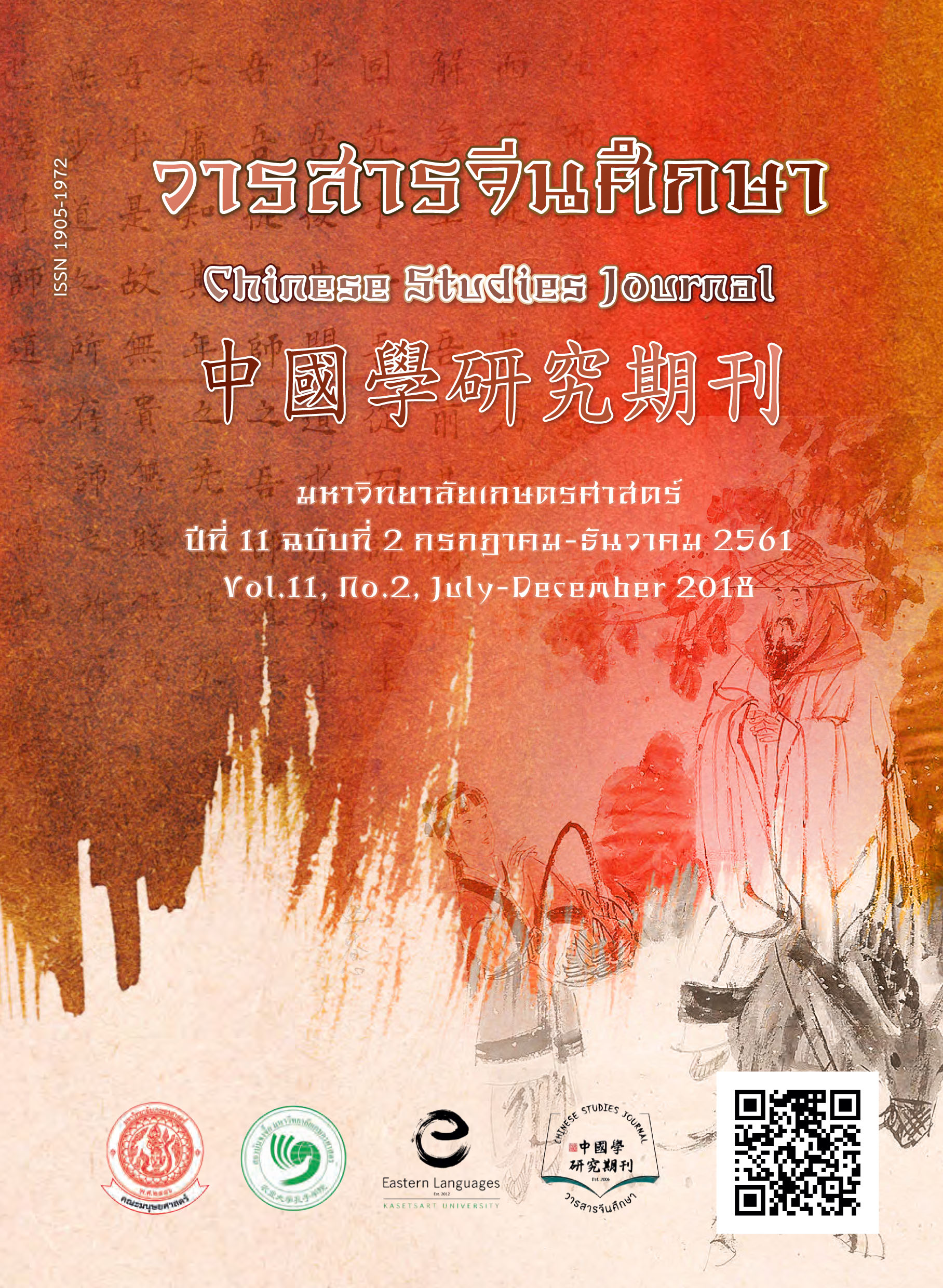A Comparative Study of Discourse Markers between Chinese and Thai Languages
Main Article Content
Abstract
Language usage for communication in daily life always consists of types of language symbols, which can generally be removed or omitted without affecting the syntactical structure, and understanding of, the true meaning of the sentence. Removal of these types of language symbols, on a pragmatic level, will have an effect on the discourse, specifically the coherence of the sentence, rendering the speaker’s intended meaning ambiguous. These language symbols both appear in Chinese or Thai, and are also known as Discourse Markers. This research adopted a language database created by the researcher and discourse analysis in order to analyses discourse markers in both the Chinese and Thai languages and was aimed at studying language deviations, functions and frequency rate of discourse markers spoken by Chinese and Thai native speakers, in order to find out which discourse markers are dominant. The study found that the discourse markers in both Chinese and Thai languages come from varied word classes as follows: conjunction, adverb, modal particle, pronoun, verb, interjection and phrase. In the Chinese language, the discourse markers mostly come from interjection and phrases, whereas the discourse markers in Thai language mainly come from modal particles. As language deviations of discourse markers in both the Chinese and Thai languages, there are deviations of phonology and graphology. In phonological deviation, the changes of consonant, vowel and intonation pronunciation were found, whereas in graphological deviation, the changes of omission or abbreviation and repetition. This research applied the theoretical framework of Schiffrin to study the function of discourse markers and found that the discourse markers used in Thai language had a distinct function of expressing politeness and intimacy; whereas in the Chinese language, the discourse markers were representative of the individual speaker. According to usage frequency by native speakers, this research applied the calculation from the database of over 1,000 characters and revealed that Thai native speakers used twice as many discourse markers than Chinese native speakers. From the results of the study, the researcher hopes that it will benefit in the study of discourse markers and clarify dominant features of discourse in both the Chinese and Thai languages.
Article Details
ผลงานทางวิชาการที่ลงตีพิมพ์ในวารสารจีนศึกษา มหาวิทยาลัยเกษตรศาสตร์ เป็นลิขสิทธิ์ของผู้เขียนหรือผู้แปลผลงานนั้น หากนำลงในวารสารจีนศึกษาเป็นครั้งแรก เจ้าของผลงานสามารถนำไปตีพิมพ์ซ้ำในวารสารหรือหนังสืออื่นได้โดยมิต้องแจ้งให้ทราบล่วงหน้า แต่หากผลงานที่ได้รับพิจารณานำลงในวารสารจีนศึกษา เป็นผลงานที่เคยตีพิมพ์ที่อื่นมาก่อนเจ้าของผลงานต้องจัดการเรื่องปัญหาลิขสิทธิ์กับแหล่งพิมพ์แรกเอง หากเกิดปัญหาทางกฎหมาย ถือว่าไม่อยู่ในความรับผิดชอบของวารสารจีนศึกษา มหาวิทยาลัยเกษตรศาสตร์ ทั้งนี้ ความคิดเห็นต่างๆ ในบทความเป็นความคิดเห็นส่วนตัวของผู้เขียน ไม่เกี่ยวกับกองบรรณาธิการวารสารจีนศึกษา มหาวิทยาลัยเกษตรศาสตร์
References
方 梅.2002.指示词“这”和“那”在北京话中的语法化,《中国语文》第4期。
胡项杰.2013.《浅析话语标记与言语规范—以“然后”为例》,《现代语文》
(语言研究版)第7期。
黄大网.2001.话语标记综述,《福建外语》第1期。
刘丽艳.2011.《汉语话语标记语》,北京:北京语言大学出版社。
吕叔湘.2015《现代汉语八百词》(增订本),北京:商务印书馆。
苗 丽.2016.话语标记“你看”的变体,《现代语文》第10期。
[泰]帕塔马·瓦萨瓦农.1996.泰语日常对话中的话语标记“NA”研究,
朱拉隆功大学硕士学位论文。
孙丽萍,方清明.2011)汉语话语标记的类型及功能研究综观,
《汉语学习》第6期。
熊子瑜.2004.“啊”的韵律特征及其话语交际功能,《当代语言学》第2期。
许家金.2008.《汉语自然会话中话语标记“那(个)”的功能分析》,
《语言科学》第1期。
曾立英.2005.“我看”与“你看”的主观化,《汉语学习》第2期。
中国社会科学院语言研究所词典编辑室.2012.《现代汉语词典第6版》,
北京:商务印书馆。
Amara Prasitharathsint. 1997. Language in Thai Society Diversity Change and Development. Bangkok: Chulalongkorn University Press.
Deborah Schiffrin. 1987. Discourse markers.New York: Cambridge University Press.
Kamchai Thonglo. 1997. Principles of the Thai Language. Bangkok: Ruamsarn Co.,Ltd.
Nawawan Panthumetha. 1982. Thai Grammar. Bangkok: Chulalongkorn University Press.
Ngampan Vejjajiva. 2016. The Happiness of Kati. Bangkok: SE-ED Books Publishing. The Royal Institute. 2004. Thai Dictionary. Bangkok: Nanmee Books Publishing.
《鲁豫有约》https://tv.sohu.com/s2015/luyuyy/
《杨澜访谈录》https://v.youku.com/v_show/id_XODUzODIyNjc2.html
《非诚勿扰》:https://fcwr.jstv.com/
《人再囧途之泰囧》https://www.youtube.com/watch?v=0I8UVr_8jYM
《爱在暹罗》https://www.youtube.com/watch?v=TcJdYgH0c9E
《初恋这件小事》https://v.baidu.com/movie/107921.html
《汉典》 https://www.zdic.net/


